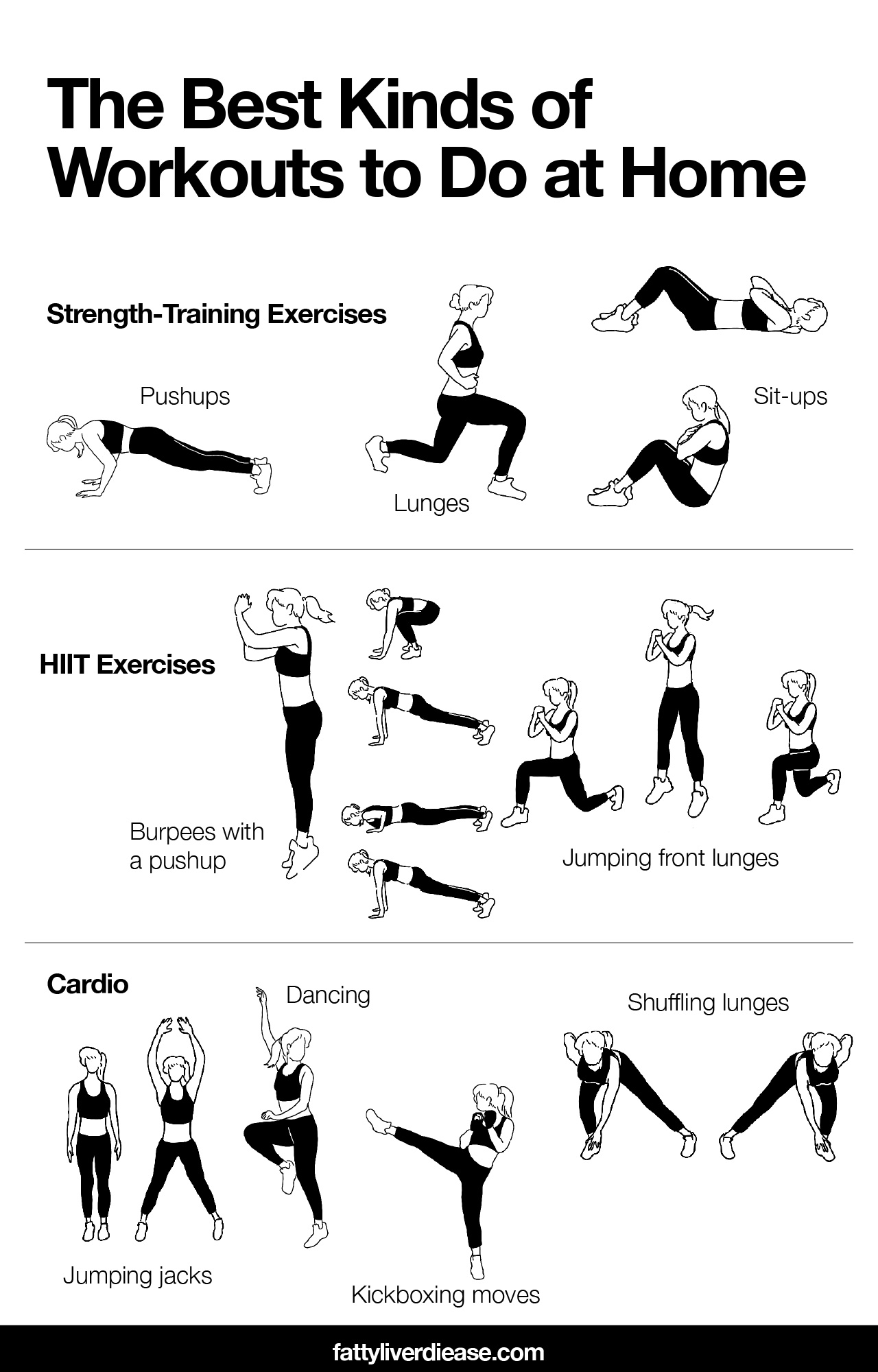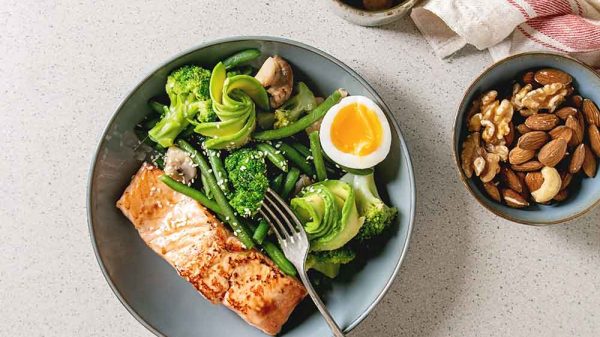Exercise is an important part of fighting metabolic conditions like fatty liver disease, type 2 diabetes, and insulin resistance. Having a home exercise program is crucial for those times when you can’t make it to the gym. In the current times, when many of us are confined to our homes in the midst of the coronavirus pandemic, having a home workout plan is essential to keeping the body healthy. Breaking a sweat while quarantined also helps relieve that stir-crazy feeling that starts to develop as days turn into weeks.
Keep reading to find out how to make the most of your exercise regimen when indoors.
The Best Kinds of Workouts to Do at Home
Luckily, you aren’t limited when it comes to workouts you can do at home! From strength training to cardio, we’ve got you covered with examples of exercises to complete at home.
Strength-Training Exercises
You can build muscle in the comfort of your own home. Effective strength-training exercises don’t require heavy-duty gym equipment or lots of space. For effective strength training, try these exercises:
- Pushups: Pushups are excellent exercises that challenge all the muscles in your arms in shoulders. To round out your upper body exercises, vary your pushup form to target different arm muscles. For example, completing pushups with your hands positioned lower down and closer to your body will target your triceps.
- Lunges: Lunges challenge the lower body muscles to lift your body weight. Much like pushups, you can vary your lunge form to target different lower body muscles. For a well-rounded workout for the lower body, vary your lunges to include side lunges, forward lunges, and backward lunges.
- Sit-ups: Doing sit-ups is foundational for abs workouts. Varying the kind of sit-ups you do targets different abdominal muscles. For example, crunches work a different area of the abs than full sit-ups. Or, performing twisting sit-ups while bicycling the legs helps work the sides of the abs as well.
HIIT Exercises
Many of us associate high-intensity interval training (HIIT) with CrossFit or intense workout classes, but in fact, there’s no need to leave your home to complete a HIIT workout routine. HIIT exercises generally involve the entire body, in order to expend as much energy as possible and to fuel your metabolism. If you want to do a complete HIIT workout, repeat the high-intensity exercise in sets of three repetitions, allowing just enough rest for a little recovery but not enough rest to allow your heart rate to slow down. Here are a few examples of HIIT exercises for your at-home workout routine.
- Burpees with a pushup: Burpees are hard enough on their own but combined with a pushup, they are even more challenging. Start in a pushup position, complete a full pushup, and get to your feet quickly and jump as high as possible.
- Jumping front lunges: These exercises put a challenging spin on the regular lunge. Begin with one leg in front of the other. Prepare for a jump by bending your knee and propelling your body upwards. As you land, switch legs so that the alternate leg is engaged in the lunge. To get your arms working simultaneously, hold them straight up in the air, and on the jump move them out to the sides. Alternate arm movements like this on each lunge. We guarantee you’ll be feeling the burn in no time!
Cardio
Think you need to leave your home in order to get your heart rate up? Think again! You can do a great cardio workout when confined in a small space. While the HIIT exercises listed above count as cardio, here are a few more exercises designed to increase your heart rate and get you sweating in no time:
- Jumping jacks: This move may be old school, but it’s popular for a reason. Jumping jacks get your arms and legs moving while increasing your heart rate.
- Dancing: Dancing is an excellent aerobic exercise that is both fun and effective. Hip-hop, Tabata, and Zumba are fun dance workouts that get you grooving to the music while supporting heart health.
- Kickboxing moves: You don’t need to be skilled at kickboxing in order to get a good workout with kickboxing. Kickboxing moves require swift motions that can challenge the arms, shoulders, leg, and glute muscles to get you sweating in no time.
- Shuffling lunges: If you want to blend cardio and strength training, shuffle side-to-side across the room, completing lunges at each end of the room before shuffling back the other way.
Tips for a Successful Home Workout Plan
Check out these tips for making the most of your quarantine workouts.
1. Choose the Most Open Space Available
When doing an at-home workout plan, the first step is choosing a space that’s comfortable. Strive to use the same space for your home workouts, so you can begin to associate that space with working out.
You can make whatever space you have available work for an at-home workout. If you live in an apartment with limited access to an outdoor space, clear out your living room or kitchen area to create enough room to do a jumping jack. If you have a yard or a porch, conduct your workouts outside to get a little fresh air and sunlight.
2. Use Household Items as Weights
Dumbbells and fancy fitness equipment are not necessary to get your muscles sore at home. Fitness guru Heidi Powell provides lots of ideas for a full-body workout you can complete at home and often uses gallon water jugs filled with water to match the weight you want to use. For example, a gallon jug that’s half full will weigh a few pounds, while a full jug will weigh closer to eight pounds.
Other items that you can use as weights include:
- Textbooks
- Bags of quinoa or rice
- Cans
You can get creative and stuff clothes, dirt, and other items into pillowcases to create your own weights.
3. Use Bodyweight Exercises
In the absence of weights, bodyweight exercises are your best friend. Bodyweight exercises can challenge all muscle groups and be just as effective for promoting muscle growth. Pushups, lunges, squats, and burpees are all excellent examples of effective bodyweight exercises.
4. Listen to Music
Music can serve as an energy boost to get your body moving and keep you focused on the task at hand. Turn on your favorite up-tempo songs while you work out. You can even incorporate dance moves into your workout routine.
Music has been proven to reach parts of our brains that language can’t. Listening to certain songs has the power to influence our moods and feelings.
5. Virtually Work Out with a Friend
It’s easy to feel lonely while social distancing and sheltering in place. During this time, take advantage of technology and keep in contact with others as much as possible. Just as you might work out with a friend at the gym, set up FaceTime, Zoom, or Skype sessions with a friend to help keep each other accountable. You can follow the same exercise routine together, or simply encourage each other as you follow separate routines. Maintaining social connections is important for supporting mental health and keeping each other motivated.
6. Tune into Livestream Workouts
As we avoid leaving our homes to slow the spread of COVID-19, more and more fitness professionals and businesses are providing opportunities for streaming live workouts. Livestreaming a workout provides guidance for proper form and a well-rounded workout, helping to keep your motivation up. Moreover, engaging in a live-streamed workout creates a community feel that also helps enhance motivation.
7. Promote Self-Care in Other Areas of Your Life
Taking care of yourself in other ways can help you feel motivated to work out and complement your fitness routine. Below we’ve listed some critical components of self-care that work synergistically with working out to promote a healthy lifestyle while in quarantine.
- Nutrition: Eating well is important for getting results from your home workouts, supporting immune function, and promoting overall wellbeing. Though getting access to certain foods may be difficult, strive to make healthy choices whenever possible. Aim for eating primarily plant-based foods like fruits, vegetables, beans, and whole grains. Supplement with high-quality proteins like lean meats and low-fat dairy, in order to get all essential amino acids needed to promote muscle synthesis and support immune health.
- Relaxation: The challenges of being in the midst of a pandemic can worsen stress and anxiety. Use some of your free time in quarantine to devote to relaxation techniques. Maybe this means taking a bath, engaging in yoga and meditation, or practicing deep breathing techniques. Like gyms and personal trainers, many yoga studios are offering live streaming opportunities. You can also unwind by reading your favorite book and watching your favorite show.
- Maintain a regular sleep schedule: Sleeping regularly is more important than ever, in order to support your mental health and overall wellbeing. When spending all of our time at home, it can become increasingly difficult to maintain a regular schedule and a consistent routine. This may lead to late nights and sleeping throughout the day, which can actually lead to more exhaustion. Instead, try to maintain a consistent bedtime and wake up time in the morning.
8. Create a Routine
During quarantine, when your day is varied by going to work or school, it can be especially difficult to stick to a routine. The days run together, your sleep schedule is disrupted, and motivating yourself to work out feels nearly impossible. Begin by writing down a daily routine to serve as a guide for dividing your day into sections. Designate one part of your day for working out and strive for approximately the same time every day. Doing so will increase your motivation and make it more likely that you’ll engage in a daily workout.
Why Is Working Out So Important While Quarantined?
Being confined to the indoors can take a serious toll on mental health. If you’re prone to depression and anxiety, getting your body moving and breaking a sweat can help release tension and quell anxious thoughts.
Spending days on end inside can also throw off the daily balance of energy exertion and rest, which can lead to insomnia. Exercising regularly with home workouts is critical for ensuring a more regular sleep schedule. Physical exertion during the day allows for a more restful sleep at night.
Conclusion
Being in quarantine doesn’t mean you need to let your fitness goals fall by the wayside. In fact, when confined to your home, particularly during a lockdown or quarantine, breaking a sweat is more important than ever. Keeping a workout schedule, eating nutritious foods, and setting aside time for relaxation is crucial to supporting your mental and physical health when confined inside.
























